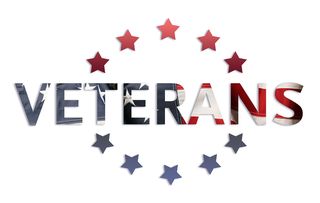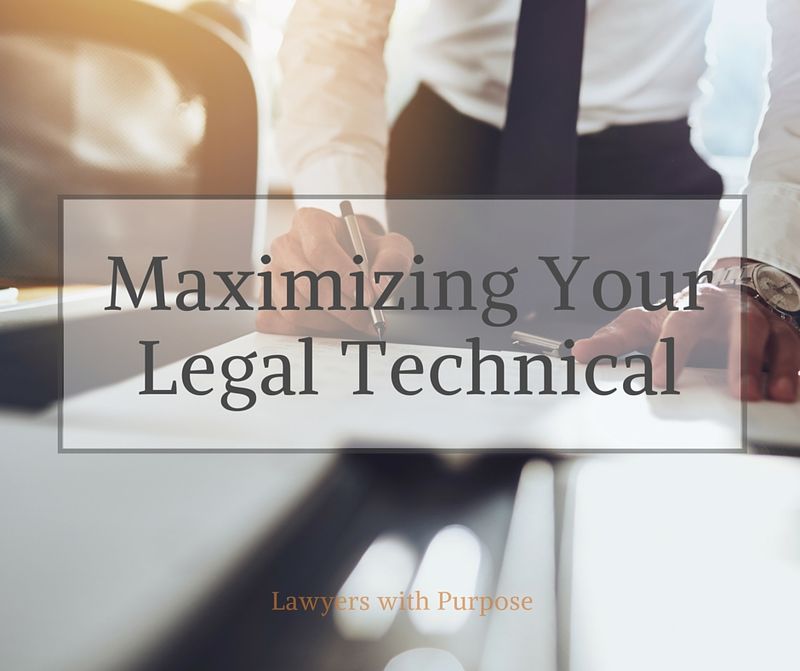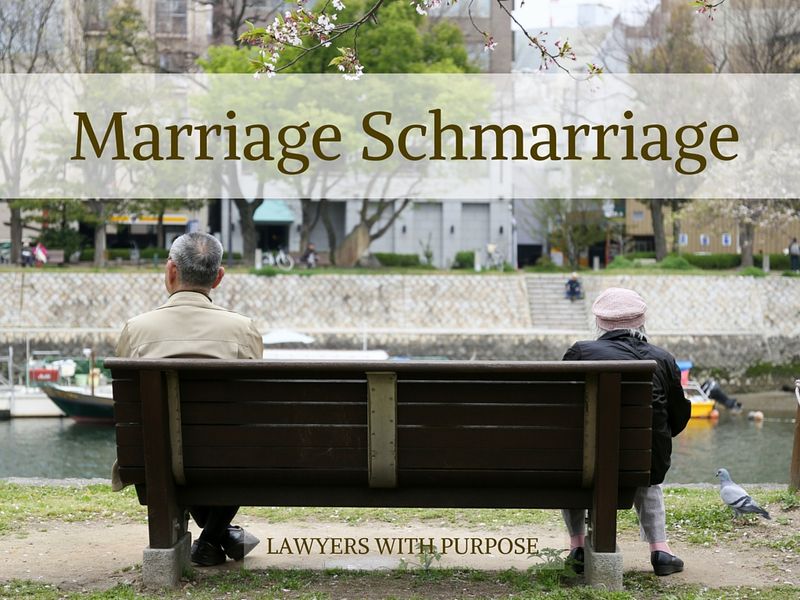Lawyers with Purpose is getting ready for some exciting changes in our legal technical training. Over the past several months, as my calendar has been freed up to provide one-on-one legal training and file reviews with members, case-specific questions for the Live Case Study review have slowly faded. As such, we are restructuring the Monday afternoon hour to continue to provide members with the most efficient use of your time and the time of your staff. Moving forward, while we will continue to address all questions that are submitted by 5 p.m. Friday on the following Monday, we will be using a large portion of the legal technical hour as an in-depth study of the Lawyers with Purpose system and the many uses of the LWP Client Centered Software.
Marriage/Schmarriage: What’s Love Got to Do with VA Non-Service-Connected Disability Pension?
Love and marriage can be of supreme importance when the Veterans Administration (VA) is considering an application for death pension from a surviving spouse. It is true that marriage is one way to document a veteran’s dependent, and this would mean an additional $332 per month to a vet’s pension in 2016. But failure to document a veteran’s marriage would certainly not be an outright bar to pension. By contrast, in the case of a surviving spouse’s claim, if you cannot document that the marriage between the surviving spouse and the veteran was valid, you have no claim at all, regardless of how eligible the surviving spouse may be otherwise.
The Medicaid Millionaire: Myth or Reality?
As the Lawyers with Purpose attorney trainer, I am often asked by transitioning attorneys or new members how I can justify helping people shelter money so that they could possibly one day receive Medicaid benefits, while still having funds available in trust. I often think as I respond, how could you not?
The Medicaid program was established in 1965. The original purpose of the program was to provide needed care for the indigent. In a 2011 House hearing on “Abuses of Medicaid Eligibility Rules,” Rep. Trey Gowdy argued that the extremely wealthy should not be on Medicaid. Medicaid is a program to alleviate impoverishment, so certainly this argument makes sense. One thing both Donald Trump and Hillary Clinton have in common is that neither should be in our offices asking how to get Medicaid benefits for long-term care.
 But Rep. Gowdy went a step further, stating that “Income and asset tests are easy to circumvent and abuse. In fact, a cottage industry has arisen seeking to educate the wealthy on how to transfer or hide assets so taxpayers can pay for their long-term care.” When I read Mr. Gowdy’s quote, certainly I was not shocked. We, as a “cottage industry” of elder care attorneys, have already been pinned “pension poachers” by the Department of Veteran’s Affairs. So, it is not a stretch to hear that we are also being labeled in this way, even though we never break or abuse a law and certainly never ask our clients to do so.
But Rep. Gowdy went a step further, stating that “Income and asset tests are easy to circumvent and abuse. In fact, a cottage industry has arisen seeking to educate the wealthy on how to transfer or hide assets so taxpayers can pay for their long-term care.” When I read Mr. Gowdy’s quote, certainly I was not shocked. We, as a “cottage industry” of elder care attorneys, have already been pinned “pension poachers” by the Department of Veteran’s Affairs. So, it is not a stretch to hear that we are also being labeled in this way, even though we never break or abuse a law and certainly never ask our clients to do so.
I would like to ask Mr. Gowdy, and all of those who paint us with the broad brush stroke of system abusers, if they actually have any idea who our typical clients are. I suspect that they do not. Because the reality is that very few multi-millionaires come into our offices seeking Medicaid benefits. No, they come in for tax planning, they come in for asset protection and they come in for family trust planning. The people who come through our doors because a spouse has just entered the nursing home and they have been asked to deplete their $250,000 in savings to pay $8,000 a month for care are not these “millionaires.” They are the hard-working, tax-paying middle class. And they are frightened, they are nervous and they know that they are quickly becoming the indigent.
Currently, long-term care beneficiaries represent about 7 percent of the Medicaid recipient population. However, they absorb about 19 percent of the Medicaid funds. Why? Because long-term care is astronomically expensive and there is no other public program available to help with the expense. It is also believed that the average pre-plan for couples who plan over five years prior to institutionalization is saving the married client between $240,000 and $750,000. These numbers decrease by over half when we look at crisis cases. When asking why they pre-planned for Medicaid eligibility, below are the answers I received from former clients.
From a former school teacher married to a Vietnam veteran: “My husband has dementia. He could be sick for a long time and I am only 68 years old.”
From a widow with an adult disabled child in her home: “My daughter has special needs and is wheelchair-bound and I need to have the money left over to care for her for the rest of her life.”
From a retired doctor and his wife, a teacher: “I paid taxes all my life and I continue to pay all that is required of me. I also donate time and money to those in need. My children work hard and I do not want to be a burden on them.”
From an auto mechanic with Parkinson’s and his wife, a retired bus driver: “My neighbor lost everything they worked for. I don’t want to die having lost everything I worked for my wife to have when she is alone.”
It is also worth noting that the “Abuses of Medicaid Eligibility Rules” hearing never grew into any proposed law changes. This is most likely because the officials from the state Medicaid agencies and the nursing care industry who were brought in to speak before the committee painted a completely different portrait of the “system abusers.” They told the stories that they see every day. They spoke of the middle class – scared, desperate, and struggling to pay for care – and the attorneys who help them manage the legalities of a complex system. They spoke of the reality, not the myth.
If you haven't registered for the June Tri-Annual Practice Enhancement Retreat we're filling up fast and Early Bird pricing expires soon! Don't miss THE estate and elder law event not to be missed! Click here to register now and reserve your spot!
Kimberly M. Brannon, Esq., Legal Technical & Software Trainer – Lawyers With Purpose
Dig, if you WILL … the truth about Prince’s estate
Doves do not cry. Crying as an expression of pain or emotion is a mammalian trait. I know this to be true because on a 6th grade trip to the zoo, dressed in my finest purple, I asked the zoologist. So I am confident in stating that if you owned a raspberry beret and spent any portion of 1986 walking into the grocery store through the out door, you understand the depths of my mourning for the death of Prince.
As a closet follower of all things pop culture, I have listened repeatedly to my Prince playlist and read every article I have run across about Prince since his death. And then, today, it happened. I read an article so blatantly ridiculous, it could not possibly be true. Who would write such an atrocious, fabricated tale, and who would believe it? Turns out the top celebrity magazine in the country wrote it, and based on the 396 comments I saw, everyone believed it. The article has since been edited. Experts in the area have been interviewed and the magazine has fixed its egregious errors. Most likely these errors were discovered when their own attorneys almost fell out of their chairs, as I did. So, I promise that I will not trouble you with the hideous nature of the original article or the depression that sank further into my soul as I browsed reader comments saying they were going to contact their police stations on the subject. I will simply tell you the title of the article, which will provide you with all of the outrage and confusion you need for the day.
Who Will Get Prince’s Millions? Cops Say They Have No Record of a Will for the Late Singer.
 Just let that sink in. As promised I will not regale you with the quotes from the original article saying that if no will is filed soon, the property of the singer who died a few days ago may be divided equally between his siblings. I will not bore you with the notion that the word TRUST was in the original article zero times. I will not tell you how the original article relied on police officers for all quotes related to probate administration. (Of course, they did not use that phrase.)
Just let that sink in. As promised I will not regale you with the quotes from the original article saying that if no will is filed soon, the property of the singer who died a few days ago may be divided equally between his siblings. I will not bore you with the notion that the word TRUST was in the original article zero times. I will not tell you how the original article relied on police officers for all quotes related to probate administration. (Of course, they did not use that phrase.)
I will simply say this: We have no idea what will happen with Prince's estate. However, this article and hundreds of others like it do send a clear message that people are being miseducated and misinformed about estate planning and administration by the media.
As elder care attorneys, we need to take seriously this article and the hundreds of comments from readers believing everything they read. Our baby boomers are reaching the age of health issues, and every family is one accident away from a crisis situation. It is our duty to continue to educate our communities through workshops on the truths about wills, trusts and administration. Understanding the importance of protecting their assets for themselves and their children is a duty LWP attorneys have to our communities, and I am proud that we do not take that lightly.
And, if you are an elder care attorney, I encourage you continue the workshops you provide to your community giving the tools and knowledge necessary to help make educated decisions about family affairs. And, providing options to attendees will potentially save thousands of dollars when crisis strikes or old age rears its ugly head.
Let us, as the LWP community working together with our clients, not give up on our goal of educating and providing the best legal advice out there for families. Let us not give up – until the doves cry.
Early Bird registration and pricing is now open for the June 20th – 24th Tri-Annual Practice Enhancement Retreat in San Diego. During the week you'll discover our most effective and PROVEN practice growth strategies, legal/technical best practices and marketing GOLD – so powerful and cutting edge we will ONLY share them face-to-face! Register today and reserve your seat at early bird pricing!
Kimberly M. Brannon, Esq., Legal-Technical and Software Trainer
VA Health Benefits
Given how much the Veterans Health Administration (VHA) has been in the news for unnecessary wait times and inappropriate scheduling practices that have negatively impacted many veterans, you may not see any value in educating your clients regarding potential VA health benefits. However, VA health benefits might offer more economical health care and/or may be an option for your clients who are underinsured. Another advantage is greater access to health care nationwide, as you may seek care at any VA health care facility once enrolled in the VA health care system.
When you enroll in VA health care, you are eligible for what is termed a Medical Benefits Package. This package consists of hospital, outpatient, and extended care services providing basic and preventive care, as well as prescription drugs, emergency care and even in some cases, services like: rehabilitative services; professional counseling and mental health services; durable medical equipment, including eyeglasses and hearing aids; home health services; reconstructive (plastic) surgery; hospice care; and dental care. What exactly is available to the recipient of VA health benefits will depend on the veteran’s unique eligibility status and whether such care or services are deemed medically necessary by VA health care providers. You receive a booklet called the Veterans Health Benefits Handbook after enrollment that gives you the specifics of your individual Medical Benefits Package.
Who qualifies for them?
If your client served in the active military, naval or air service and was discharged under any condition other than dishonorable, the client may qualify for VA health care benefits. There is a minimum duty requirement for veterans who enlisted after September 7, 1980, but there are also many exceptions both before and after this date, so you should consult 38 CFR §17.31 Duty periods defined for the definitions of duty periods applicable to eligibility for medical benefits.
Although family members, with very limited exception, cannot access the VA health care system, family members of veterans may be eligible for CHAMPVA. This is a program that provides health insurance coverage to dependents of a qualifying sponsor who is, or was at the time of death, rated permanently and totally disabled due to a service-connected disability or who died of a service-connected disability.
How do you enroll?
You can apply for VA health care by completing VA Form 10-10EZ Application for Health Benefits and submitting it in person or by mail to the enrollment coordinator at any VA Medical Center. The 10-10EZ form has sections to complete with information about military service, health insurance, and finances. Private health care insurance does not affect eligibility for VA health care. The instructions for the financial section specify that only non-service-connected and service-connected veterans rated at 0% must provide this financial information. However, they go on to state that those receiving VA pension or compensation and/or Medicaid benefits, among others, are not required to disclose financial information. In fact, after a claimant is approved for non-service-connected pension, he/she should be automatically mailed enrollment information for the VA health care system. The financial information is used to determine eligibility and copay responsibility for VA Health Benefits and – with the exceptions noted above – may be a requirement of enrollment.
More information
As part of enrollment, the applicant is assigned to a Priority Group based on the severity and nature of the applicant’s disability and/or income. There are eight Priority Groups for enrollment, from highest priority at #1 to the lowest at #8:
- Veterans with service-connected disabilities 50% or more disabling, or those unemployable due to service-connected conditions;
- Veterans with service-connected disabilities 30% or 40% disabling;
- Veterans who were Prisoners of War (POWs), were awarded the Purple Heart or Medal of Honor, whose discharge was for a service-connected disability, with service-connected disabilities 10% or 20% disabling, or special eligibility under Title 38, U.S.C. § 1151;
- Veterans receiving aid and attendance or housebound VA benefits or who have been determined by the VA to be catastrophically disabled;
- Non-service-connected veterans and non-compensable service-connected veterans rated 0% disabled with annual income below the VA’s and geographically (based on your resident ZIP code) adjusted income limits, veterans receiving VA base pension benefits, or eligible for Medicaid programs;
- Compensable service-connected veterans rated at 0% and various categories of veterans whose military service meets certain requirements;
- Veterans with gross household income below the geographically adjusted income limits (GMT) for their resident location;
- Veterans with gross household income above the VA and the geographically adjusted income limits for their resident location.
The Priority Group assignment will determine what the VA Health Benefits enrollee will pay, if anything, in copayments for their health benefits. Generally, the cost of care is free when related to service-connected disabilities, but there may be a copay for all other services, to include prescriptions.
Despite the fact that, when the VHA makes headlines, it’s often not for a good reason, the news isn’t all bad. The VA has taken corrective action to identify and resolve the issues that have plagued the VHA, including requesting the VHA to conduct an audit which then led to the Accelerating Access to Care Initiative. The VA also publishes comprehensive monthly updates detailing pending and completed appointments and average wait times that allow for oversight, and also allow a beneficiary to select a VA Medical Center with lower wait times when there is more than one in their area. For further information on Veterans Health Benefits beyond this overview, consult the website of the Veterans Health Administration at http://www.va.gov/health/.
If you aren't a Lawyers With Purpose member and want to learn more about how we can help you in your estate or elder law practice, click here and join our FREE webinar on Thursday, April 21st at 8 EST "Four Essentials For A Profitable Practice". On this one hour webinar, you'll discover:
- How to turn the complexity of Medicaid and Asset Protection Laws into simple value creation that is easy for clients to identify, allowing you to enroll more prospects into paying clients.
- Proven ways to get to YES faster and EASIER…with less "selling," pressure, or having to later overcome buyer's remorse.
- Why a confused or overwhelmed client will always say NO, and how to instead "show the law" (not TEACH IT) to more effectively earn new business.
- The key "stories" you must tell during the initial meeting (or workshop) so that clients can relate and deeply understand the value you provide (…even when your services cost 5X more than the competition down the street!).
- How to implement time management secrets of successful entrepreneurs, so that you are able to do more in your practice in less time, and have free time left over to do what you love.
- Effective ways for working on the business (not in the business) in order to master lead generation, lead conversion, and serve your clients to create consistent cash flow.
- Discover the key metrics that should be the sole focus of managing your practice…and how successful estate planning and elder law attorneys leverage tracking and reporting to reach their goals.
- Discover the five essential roles that you and your staff must fill to achieve a consistently profitable practice.
Click here to register and reserve your spot now.
By Sabrina A. Scott, Paralegal, The Elder & Disability Law Firm of Victoria L. Collier, PC and Director of VA Services for Lawyers With Purpose.
Victoria L. Collier, Veteran of the United States Air Force, 1989-1995 and United States Army Reserves, 2001-2004. Victoria is a Certified Elder Law Attorney through the National Elder Law Foundation; Author of “47 Secret Veterans Benefits for Seniors”; Author of “Paying for Long Term Care: Financial Help for Wartime Veterans: The VA Aid & Attendance Benefit”; Founder of The Elder & Disability Law Firm of Victoria L. Collier, PC; Co-Founder of Lawyers with Purpose; and Co-Founder of Veterans Advocate Group of America.
Advising Trustees of Special Needs Trusts on Spending Issues
Special Needs Trusts are often created with funds received from legal settlements or inheritances. Special Needs Trusts are important documents when established for people who are receiving government benefits. However, as practitioners we must remember that a Special Needs Trust must not only be effectively drafted for those receiving public benefits, the trustee must also make distributions in accordance with the guidelines of the trust so as not to risk loss of Supplemental Security Income (SSI) or Medicaid benefits for the beneficiary.
The first place a trustee should look when making a distribution from an SNT is the four corners of the document. Even though the state code may allow a distribution, if the trust instrument itself does not, the trustee must abide by the language of the trust. For example, most states will allow SNT funds to be used to pay for vacations, but if the trust instrument itself states it is not to be used for “travel expenses,” the trustee is now limited beyond what the state code might allow. However, once the trustee is familiar with the limitations of the trust document, he should look to the state code and what programs the beneficiary is on for any other limitations on disbursement.
 Special Needs Trust payments are designed for “supplemental” or luxury needs not provided for by government benefits. SNT funds are not intended to be used for basic shelter or food, as those needs are provided for by the government benefits. Any money from the trust spent on food or shelter on a regular basis, or given directly to the beneficiary, can count as income for government benefit purposes.
Special Needs Trust payments are designed for “supplemental” or luxury needs not provided for by government benefits. SNT funds are not intended to be used for basic shelter or food, as those needs are provided for by the government benefits. Any money from the trust spent on food or shelter on a regular basis, or given directly to the beneficiary, can count as income for government benefit purposes.
If a beneficiary is receiving SSI benefits, the trustee should be cautious not to make payments directly to the beneficiary, payments to restaurants or grocery stores, mortgage or rent payments, or tax payments on the home. Some jurisdictions also frown on disbursements to basic utility companies, stating that those payments are covered by the SSI payment. Most of these types of payments will result in a 1/3 loss of SSI income. So, while they are discouraged disbursements, there may be some cases in which the trustee determines that the benefit of making the payment outweighs the loss of SSI income. For example, if the beneficiary is unable to pay the tax notice on his home, the trustee may decide to pay the taxes and let that money count as income for the beneficiary the month it was paid. In this scenario, the loss of the 1/3 income is far outweighed by keeping the home taxes up to date, assuring that the beneficiary has a place to live.
When institutionalized clients come to us with a Special Needs Trust, we must be cautious with distributions as well. However, there are plenty of supplemental needs the money can pay for. Nursing home patients can use the money in an SNT to pay the additional fee for a private room, a television, eye glasses and tooth care not provided for by Medicaid, the travel expenses and mileage of the sponsor to come and check on the patient, and caregiver expenses. Oftentimes, nursing homes are happy to hear that a patient has a Special Needs Trust to pay for additional expenses that arise, and some homes will look more favorably upon Medicaid and Medicaid-pending patients who have such funds to “supplement” care costs.
The LWPCCS software allows us to create both first-party and third-party Special Needs Trusts that conform with the federal and state requirements and allow the greatest discretion possible to your trustees. It is, of course, important that the trustee understand what distributions he can make and that he contacts an attorney with disbursements he is unsure of. This type of trustee guidance is a great opportunity for us to provide our clients with our understanding and counsel through a maintenance plan.
If you are interested in seeing our estate planning drafting software first hand, just click here and schedule your live complementary demo.
Kimberly M. Brannon, Esq., Legal-Technical and Software Trainer
Utilizing the New LWP-CCS Personal Services Agreement
Personal service agreements, or personal care agreements, are typically agreements between a family member providing care and another needing care. These agreements act as a legal contract between the two parties regarding the range of care one party is providing to the other. As a Medicaid and/or VA planning tool, a personal service agreements may act as a method of spend-down while making sure your elderly client is provided the services needed and is appropriately compensating a family member who is making personal and professional sacrifices to provide the services.
We are excited to share that the LWP Client-Centered Software is now providing a comprehensive Personal Services Agreement that thoroughly addresses the many issues that Medicaid will consider when analyzing a care plan. The care plan also offers the language you will need if a client starts receiving VA benefits and plans to pay those to a child or family member to provide care.
 First, the software incorporates all parties involved in the plan and requires that all parties sign the plan.
First, the software incorporates all parties involved in the plan and requires that all parties sign the plan.
Medicaid wants to make sure that the compensation offered to the caregiver is reasonable in the area of the country where the services are provided. The LWPCCS incorporates the hourly rates of court-appointed guardians, geriatric-care professionals and general-service providers to justify the hourly rate paid to the caregiver. If you opt to do so, the software can calculate the hourly rate of the caregiver as the average of the rates provided for the professionals mentioned above.
Medicaid will want to know where the care is provided. This can be especially important if the child is moving in with the parent to provide care in lieu of nursing care, as they may later qualify for the child caregiver exemption. The software assumes the care is at the home of the person needing care. However, with the click of a button you can choose another place of care, be it in the child’s home, an assisted living facility, an independent living facility or a nursing home.
The terms of the agreement are an important part of creating a valid contract and meeting Medicaid requirements. The LWPCCS allows you to determine the start date of the agreement, the term of the agreement (lifetime, term of years or term of weeks), how often the caregiver will be paid, and the hourly rate the caregiver receives. Another important note: When the caregiver agreement is produced, it defines the caregiver’s role as that of a general contractor and eliminates any tax liability for the person receiving care, providing additional protections for your client.
The feature of the software that allows you to specify which activities of daily living (ADLs) the person needs assistance with can help with Medicaid guidelines and VA guidelines as well.
Finally, alternate caregivers are named for any time periods during which the caregiver is unable to perform the tasks, due to personal illness, vacation, other employment or any other reason.
You can find the new personal services agreement in the LWPCCS under the Medicaid Qualification folder, since we see it as a critical part of Medicaid planning. Incorporating the new LWP Personal Care Agreement into your practice is yet another layer of solid legal planning and documentation we provide for our clients as LWP attorneys.
If you want to learn more about adding medicaid to your estate or elder law practice register for our FREE WEBINAR "Simplifying Medicaid Eligibility & Qualified Transfers" on Tuesday, March 15th at 2 EST. Click here to reserve your spot now.
Here's just some of what you'll discover…
- Understanding the 12 Key terms of Medicaid
- Learn the Qualification Standards: Does Client Meet Needs Tests?
- Learn the Medicaid Terms of Art
- Learn the Snap Shot, Look Back/Look Forward Distinction: And how to put it all together
- At the end of the event receive an ALL STATES Medicaid Planning Resource Guide
- …and much, much more!
Just register here to reserve your seat… it's 100% FREE!
Kimberly M. Brannon, Esq., Legal-Technical & Software Trainer, Lawyers With Purpose
House Bill 4351: Going After Pension Poachers
House Bill 4351 should be stopped!
For the past several years, bills have been introduced for Congressional approval that would impose a three-year look back, and penalties up to 10 years, for veterans and their spouses who give away their assets and then apply for a pension program designed for indigent wartime veterans. The bills were limited to addressing the concerns of deliberate impoverishment by veterans with the help of lawyers, financial advisors, and others. The bills never passed.
 In January 2015, the Veterans Administration published proposed changes to the laws in the Federal Register that would change Title 38 of the Code of Federal Regulations. The VA included penalties for transfers of assets, and used very broad definitions of transfers (i.e. the purchase of an annuity), just like the previous bills that had been introduced. However, the VA went much further, proposing to (1) extend beyond its Congressional authority and (2) extend beyond the scope of the perceived needed changes.
In January 2015, the Veterans Administration published proposed changes to the laws in the Federal Register that would change Title 38 of the Code of Federal Regulations. The VA included penalties for transfers of assets, and used very broad definitions of transfers (i.e. the purchase of an annuity), just like the previous bills that had been introduced. However, the VA went much further, proposing to (1) extend beyond its Congressional authority and (2) extend beyond the scope of the perceived needed changes.
Beyond VA Authority.
Under the pension program for wartime veterans, the claimant must meet an income and asset standard. With regard to income, the VA deducts from gross income all permissible medical expenses. Home healthcare is a permissible medical expense. But the VA proposed to limit the deduction to the average cost of home healthcare based on a national average set two years prior to the proposed changes, which would be $21 per hour. The law is clear that if a medical expense is deductible, then the entire amount must be deducted, and a change of this nature is in violation of the Congressional right.
Beyond the Scope
The purpose of the bills introduced into Congress and the purpose of the proposed changes to the VA regulations is to prevent people from divesting themselves of assets, which they otherwise could use for themselves to pay for care, in order to qualify for tax-free income from the VA to pay for their care. The VA exceeded the purpose of these bills when they included in the proposed changes a limitation on the lot coverage for veteran’s home place. The home place and a reasonable lot area have always been exempt by the VA when applying for pension. A reasonable lot area has always been defined as the same or similar in size to those in the same community or neighborhood. Rather than keeping the long-standing laws, the VA wants to count any property value that exceeds two acres. This makes no sense under the purpose of the law changes to keep people from divesting themselves of assets. First, a 900-square-foot condo in New York City may be worth well over $1,000,000, but it would be an exempt resource under the proposed changes. Whereas, a house sitting on five acres in south Georgia would be a countable resource, even if its value is only $150,000. Moreover, the veterans may have been living in the house for 10, 20, 30 years or more and had no intention of ever filing for the VA pension when they bought the house. Thus, the change in the law has nothing to do with the perceived abuses of people trying to save their assets and qualify for benefits.
Congress has apparently given up on trying to pass a bill that specifically details a look back and penalties for wartime veterans who give money away to qualify for the pension. After all, this is an election year and that would not look very good.
Nonetheless, a few members have found a sneaky way to get the VA’s proposed changes passed by Congress without Congress necessarily knowing what they are actually passing. House Resolution 4351, submitted in the House of Representatives on January 8, was sponsored by Rep. Matt Cartwright of Pennsylvania and co-sponsored by Rep. Sanford Bishop of Georgia, Rep. Sheila Jackson Lee of Texas and Rep. Walter Jones of North Carolina. It has been referred to the Committee on Veteran’s Affairs.
Its stated goal is “To protect individuals who are eligible for increased pension under laws administered by the Secretary of Veterans Affairs on the basis of need of regular aid and attendance from dishonest, predatory, or otherwise unlawful practices, and for other purposes.” The act would be titled, “Veterans Care Financial Protection Act of 2016.”
This sounds really good, because Congress is professing to protect veterans from financial predators. Second, the act does nothing more than mandate that the secretary of the VA work with the heads of federal agencies, states, and such experts as the secretary considers appropriate to “develop and implement Federal and State standards to protect individuals from dishonest, predatory, or otherwise unlawful practices.” The VA would then have 180 days to submit the standards to the Committee on Veterans’ Affairs of the Senate and of the House of Representatives. If this resolution passes, the VA can just hand over the proposed changes in the laws as the standards. The resolution does not say what the two committees are to do once they receive the standards from the VA.
The VA plans to finalize proposed changes (with modifications) by early summer. What is unclear is whether a passage of this “blind” resolution would immediately sanctify any changes the VA has made, or if the changes cannot take effect until after the two committees have taken some action of approval. What is clear is that advocates and veterans must once again push to make your political leaders, specifically those in the two Veterans’ Affairs committees, aware of these damaging changes that have no bearing on the purpose of the proposed changes – limiting home healthcare to an outdated national average and limiting the home place lot coverage to two acres instead of a reasonable lot for the area.
If you would like to know more about the VA Proposed 3 Year Lookback and Other Law Changes join our FREE WEBINAR on Wednesday, March 16th at 4EST. Click here to reserve your spot today.
Victoria L. Collier, Co-Founder, Lawyers with Purpose, LLC; Certified Elder Law Attorney through the National Elder Law Foundation; Fellow of the National Academy of Elder Law Attorneys; Founder and Managing Attorney of The Elder & Disability Law Firm of Victoria L. Collier, PC; Co-Founder of Veterans Advocates Group of America; Entrepreneur; Author; and nationally renowned Presenter.
Who Should Be Trustee?
There's a constant battle between lawyers as to who should be trustee of an irrevocable asset protection trust. The primary school of thought is that it should never be the grantor, and some schools of thought believe it should never be the beneficiary. At Lawyers with Purpose, we disagree with both of those positions, but we recognize the concerns and rely on sound principles of asset protection law in making the final determinations.
 Let's first discuss the question of whether the grantor should be trustee. Many practitioners believe that allowing the grantor to be trustee makes the assets of an irrevocable trust available to the grantor's creditors. Such a proposition is ludicrous. The challenge with most lawyers is that they do not allow the grantor to be trustee of his or her irrevocable trust. When pushed to explain why, they typically assume that's the way it was always done. Few dig further to see why it was done that way. So let's examine why grantors were not traditionally named trustee. The most adverse impact is that, if the grantor is trustee, they're deemed to retain enough control to have the assets of the trust included in their taxable estate when they die. For many generations, this was the death knell? of an asset protection trust. But in the last 15 years it's become irrelevant because of the rise of the estate tax exemption. Today only two in a thousand Americans have a taxable estate, so preventing the grantor from being trustee because of a potential inclusion of the trust asset in the estate of the grantor is not relevant to 99.8 percent of Americans. So why hold them to that standard?
Let's first discuss the question of whether the grantor should be trustee. Many practitioners believe that allowing the grantor to be trustee makes the assets of an irrevocable trust available to the grantor's creditors. Such a proposition is ludicrous. The challenge with most lawyers is that they do not allow the grantor to be trustee of his or her irrevocable trust. When pushed to explain why, they typically assume that's the way it was always done. Few dig further to see why it was done that way. So let's examine why grantors were not traditionally named trustee. The most adverse impact is that, if the grantor is trustee, they're deemed to retain enough control to have the assets of the trust included in their taxable estate when they die. For many generations, this was the death knell? of an asset protection trust. But in the last 15 years it's become irrelevant because of the rise of the estate tax exemption. Today only two in a thousand Americans have a taxable estate, so preventing the grantor from being trustee because of a potential inclusion of the trust asset in the estate of the grantor is not relevant to 99.8 percent of Americans. So why hold them to that standard?
The next major argument is a theory that if the grantor has control of the trust, then he could direct it back to himself. Well, that depends. What does the trust say? If the trust says that the grantor is not a beneficiary, or similarly the grantor is not a principal beneficiary but is entitled to the income, does that mean that the grantor as trustee all of a sudden gains a super power to violate the terms of the trust and give himself the principal when it's not allowed for? Hardly. In fact, there is consistent case law throughout all of the states, including cases that lead all the way up to the Supreme Court, that supports the notion that a grantor as trustee has all of the same fiduciary obligations as any other trustee and by no means has authority to act outside the powers granted to trustee. I specifically refer you to my Law Review article, "The Irrevocable Pure Grantor Trust: The Estate Planning Landscape Has Changed" in the Syracuse Law Review. In this article, I go through in‑depth review of all of the case law nationwide, and I'm excited to say that it is sound law that a grantor can be a trustee without risking the assets to the creditors of the grantor. One caveat, however, is if the grantor does retain the right to the income, then absolutely the income will be available to the creditors of the grantor.
So are there circumstances when the grantor as trustee's trust is invaded? Absolutely, but in every single case the invasion was not due to the grantor being the trustee, but rather was due to the pattern of behavior by a grantor trustee who violated regularly the terms of the trust in favor of themselves, and the trust was thereafter deemed a sham. In such cases, I concur with any court that makes that decision based on people who try to defraud the system. Irrevocable trusts must be managed in an arm's length manner, and as lawyers we do not plan for someone to become fraudulent. They are fraudulent to their own peril. But a properly drawn trust when the trustee is the grantor in no way, shape or form creates any risk of loss of asset protection if the terms of the trust are followed, as they are required to be in every case whether the grantor is trustee or not.
So at Lawyers with Purpose we encourage our members to do good legal work based on sound law, not fear, conjecture or because that's the way it's always been done. In the end, the client wins. It is silly to deny thousands of clients that we serve the ability to manage and control their own assets for the benefit of their families, just because some rogue case in some rogue state from some vile fact pattern allowed the court to invade against the intentions of the grantor. Protect your clients. Teach your clients. Share with your clients how these work. They are very safe and a great planning tool.
If you want to learn more about Lawyers With Purpose you can find all the information about becoming a member by clicking here to download our Membership Brochure.
David J. Zumpano, Esq, CPA, Co-founder Lawyers With Purpose, Founder and Senior Partner of Estate Planning Law Center
VA form 21-8049 – Request for Details of Expenses
For all you high Fact-finder/Follow through Kolbe types, don’t panic if the VA form 21-8049 number means nothing to you. It shouldn’t necessarily. If you file non-service-connected pension claims with the VA, you may never have had occasion to use this form, which is formally called a “Request for Details of Expenses.” It is not generally part of what Lawyers with Purpose considers a fully developed VA claim, although there are those who routinely include this form with all their VA claims.
As the name of VA form 21-8049 suggests, its main purpose is to report monthly non-medical expenses as well as expenses of dependents that otherwise are not typically reported on any other forms one submits with a fully-developed claim. The 21-8049 is usually sent to a claimant to be completed when the VA requires further information after the formal claim is filed. In fact, the VA specifically states in the instructions at the top, “We need additional information to determine whether you are entitled to benefits.” The VA may request this additional information because the adjudication manual directs the adjudicator to determine “whether or not the claimant’s financial resources are sufficient to meet his/her basic needs without assistance from VA. If a claimant’s assets are large enough that the claimant could use these assets to pay living expenses for a reasonable period of time, net worth is considered a bar,” M21-1 Adjudication Procedures Manual, Part V, Subpart I, Chapter 3, Section A.1.e. The 21-8049 may not be requested for every claim you file, but if it is requested, it can delay the claim process. For that reason, some choose to include this form with every formal claim they file. Or, you may decide to complete this form only when your claimant has unusually high non-medical living expenses that you want to make evident to the VA.
How to complete the 21-8049
The current version of this form is dated Aug 2007 in the lower left corner of the first page, although the VA still accepts older versions. It is a two-page form that consists of seven sections. The instructions are minimal, but the VA does provide a toll-free number to call for assistance. Like any other VA form, it is recommended that you complete every section. Non-applicable sections should be crossed out, or you should otherwise indicate that these do not apply. Sections I and II are for listing dependents – both those living with the claimant and those not living with the claimant. Furthermore, you can specify the amount, if any, that the claimant contributes to the support of dependents not living with the claimant so that the VA will consider these amounts when evaluating whether the claimant’s net worth is sufficient.
Sections III, IV, V, and VI are for “Monthly Expenses (except medical) for you and those listed above as living with you,” “Hospital and Medical Expenses,” “Educational Expenses,” and “Expenses of Last Illness and Burial of Veteran, Spouse, or Child and Just Debts of Deceased Veteran or Parent’s Spouse,” respectively. The completion of these four sections is fairly straightforward, but a few remarks should be made to avoid potential problems. Section III lists several possible monthly expenses, like Housing, Food, Taxes, etc., and it also provides blanks for inserting other types of expenses, but this section is only for reporting non-medical expenses. For example, the line item “Housing” should not be used for reporting fees for a nursing home or assisted living facility. Instead, total medical expenses that were reported on the VA form 21P-8416 “Medical Expense Report” with the formal claim should be reported in Section IV, “Hospital and Medical Expenses,” along with a brief breakdown of the medical expenses, or simply refer the VA to the already submitted form 21P-8416. Finally, section VII is for reporting “Commercial Life Insurance Payments” to the claimant. While life insurance payouts are not considered income by the VA if the insured was a veteran, these will be considered as part of net worth and could potentially put a claimant over the asset limit unless you can document to the VA that these assets have been spent down.
What to file with the 21-8049
Documentation of the expenses listed on this form is not required but may assist in your claim. If you decide you want to start including the 21-8049 with all your formal claims, you may decide not to include further supporting documentation unless later requested by the VA. If you do refer to the VA form 21P-8416 in Section IV, you may want at least to include a copy of this form for the adjudicator’s convenience. However, if the VA sent you the form 21-8049 to be completed, they may have requested other information as well. In such cases, ensure that you submit the VA form 21-8049 with anything else requested in the VA correspondence, and that you respond by any deadlines the VA may specify.
If you want to lear more about the Veterans Administration Proposed 3 Year Lookback and Other Law Changes join our FREE WEBINAR on Wednesday, March 16th at 4 EST. Just click here to reserve your spot. Here's what you'll get:
Discover the Nuts and Bolts of the Proposed VA Changes…and What it Means for Your Practice!
On Friday, January 23, 2015, the Veterans Administration proposed changes in the Federal Register that would…
- Impose a three year lookback for transfers of assets, including gifts to persons, trusts, or purchases of annuities.
- Deny claims for up to 10 years due to transfers.
- And exempt only the home and two acres from net worth. If a claimant's property exceeds two acres, it will count toward the net worth figure for eligibility.
By Sabrina A. Scott, Paralegal, The Elder & Disability Law Firm of Victoria L. Collier, PC and Director of VA Services for Lawyers With Purpose.
Victoria L. Collier, Veteran of the United States Air Force, 1989-1995 and United States Army Reserves, 2001-2004. Victoria is a Certified Elder Law Attorney through the National Elder Law Foundation; Author of “47 Secret Veterans Benefits for Seniors”; Author of “Paying for Long Term Care: Financial Help for Wartime Veterans: The VA Aid & Attendance Benefit”; Founder of The Elder & Disability Law Firm of Victoria L. Collier, PC; Co-Founder of Lawyers with Purpose; and Co-Founder of Veterans Advocate Group of America.





